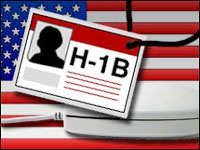 On April 1, 2011, the United States Citizenship and Immigration Service (USCIS) began accepting H-1B visa applications for the 2012 fiscal year (which starts on October 1, 2011). In 2008, U.S. Citizenship and Immigration Services (USCIS) received approximately 163,000 petitions during the five-day filing period and conducted a random lottery to select the 65,000 petitions that would be eligible for processing. In 2007, the USCIS reached its H1-B visa quota in one day. Due to the slump in the economy, last year was the first year where all H-1B visas were not taken until the end of January 2011.
On April 1, 2011, the United States Citizenship and Immigration Service (USCIS) began accepting H-1B visa applications for the 2012 fiscal year (which starts on October 1, 2011). In 2008, U.S. Citizenship and Immigration Services (USCIS) received approximately 163,000 petitions during the five-day filing period and conducted a random lottery to select the 65,000 petitions that would be eligible for processing. In 2007, the USCIS reached its H1-B visa quota in one day. Due to the slump in the economy, last year was the first year where all H-1B visas were not taken until the end of January 2011.
The H-1B visa program enables U.S. employers to hire highly educated foreign professional workers for “specialty occupations” — jobs that require at least a bachelor’s degree or the equivalent in the field of specialty. These foreign workers provide needed specialized or unique skills, fill a temporary labor shortage and/or supply global expertise. Holders of these visas can stay in the United States for up to six years.
Although it is unlikely that the USCIS will reach its H-1B cap for the 2012 fiscal year soon after April 1, 2011, employers seeking H-1B visas should start planning ahead. Unlike in previous years, obtaining a certified Labor Condition Application (LCA) is no longer immediate upon submission online. Now employers have to submit the LCA to the Department of Labor and wait up to seven days if not longer to obtain an approved LCA. The LCA contains several attestations by the employer including an attestation that they will pay the H-1B employee the prevailing wage for the job position.
Many employers have already experienced delays in obtaining an approved LCA where the Department of Labor cannot verify the employer’s tax identification number and requires additional documentation before providing an approved LCA.
Prudent employers need to start considering and planning their H-1B visa needs for the upcoming fiscal year. It is also advisable for employers to start making contingency plans for bringing temporary professional workers to the United States if the H-1B cap is reached.
WHY THE EARLY H-1B VISAS CUT-OFF?
-1B visas are limited to 65,000 per year. However, certain cases are exempt from the cap. This numerical limit is further reduced by free trade agreements that specifically allocate 6,800 H-1B visas for nationals of Singapore and Chile making only 58,200 visas available in the standard H-1B pool.
WHO IS EXEMPT FROM THE H-1B CAP?
The following cases are exempt from the H-1B cap: 1) extensions for current H-1B workers, whether for a new or existing employer in sequential employment situations; 2) concurrent employment in a second H-1B position; 3) amended petitions; 4) H-1B employment for nationals of Chile or Singapore, 5) petitions for new employment at an exempt organization such as a nonprofit research organization, an institution of higher education or an affiliated non-profit entity and 6) 20000 H-1B visas for graduates of U.S. universities who have earned a Master's or higher degree.
IMPACT OF THE EARLY CUT-OFF OF H-1B VISAS
After the H1-B cap is reached, private employers cannot hire new temporary professional workers in H-1B status for the 2012 fiscal year. For those employers in need of hiring temporary professional foreign workers after the H-1B cap is reached, there may be alternative options available.




